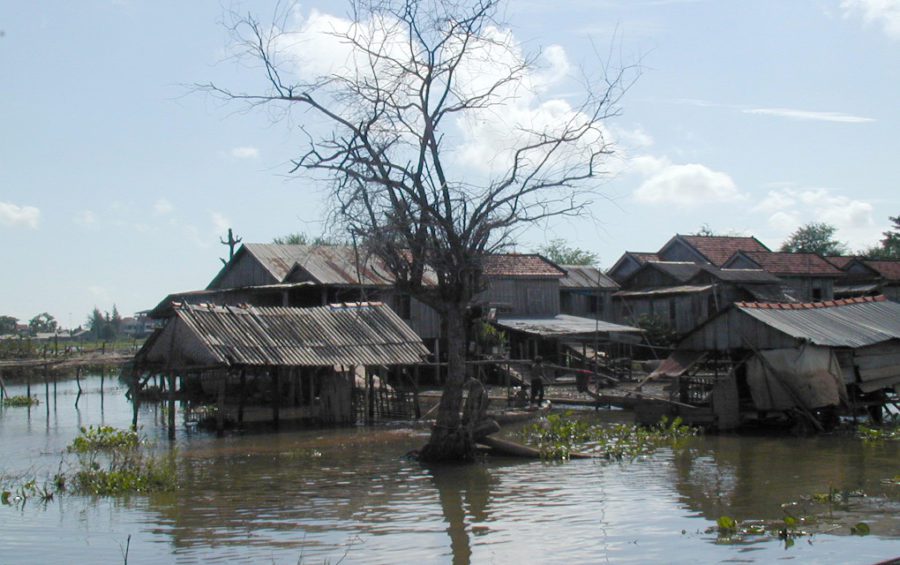This week, VOD published a number of stories that looked at the global challenge of addressing climate change, through a local lens, as part of the international news collaboration Covering Climate Now.
 Hun Vannak is an activist with environmental advocacy group Mother Nature Cambodia.
Hun Vannak is an activist with environmental advocacy group Mother Nature Cambodia. Karolien Casaer-Diez is the country representative of Global Green Growth Institute, which promotes sustainable economic growth in developing nations.
Karolien Casaer-Diez is the country representative of Global Green Growth Institute, which promotes sustainable economic growth in developing nations. Laurie Parsons is a postdoctoral research fellow at Royal Holloway, University of London. He researches and writes on climate change and development in Cambodia.
Laurie Parsons is a postdoctoral research fellow at Royal Holloway, University of London. He researches and writes on climate change and development in Cambodia. Sarah Milne is a senior lecturer at Australian National University’s Crawford School of Public Policy. Her research focuses on political ecology in Cambodia.
Sarah Milne is a senior lecturer at Australian National University’s Crawford School of Public Policy. Her research focuses on political ecology in Cambodia.
Along with more than 250 news outlets around the world, VOD published articles about climate change in the run-up to the U.N. Climate Action Summit on September 23 to make clear that the news media has an important role to play in educating the public and world leaders about what the U.N. has called the “defining issue of our time.”
On Monday, we previewed our news coverage, noting the serious climate risks Cambodia faces, while highlighting some of the things individuals can do to cut their carbon footprint.
On Tuesday, contributor Danielle Keeton-Olsen dove deeper into Cambodia’s climate change risks and reported on the nation’s rising emissions. We also reported on the deadly toll of flooding this month, which killed at least 12 people and forced more than 10,000 families from their homes across seven provinces.
The next day, we shared a compilation of everyday capital residents’ climate concerns, from heat and flooding to deforestation and disease, in the first work produced by VOD’s trainee reporters.
Then, on Thursday, Danielle again dug into an undercovered climate story in Cambodia: how changing weather cycles are shaking up Kampot’s natural salt industry and leaving producers wondering whether than can carry on.
Today, we wrap up our weeklong coverage by asking four people — including an environmental activist, a sustainable growth advocate and two climate researchers — the same nine questions about Cambodia’s place in the climate conundrum and how the nation might contribute to addressing the various challenges posed by human-caused climate disruption, and adapt and mitigate its impacts, today and in the years to come.
Here’s what they told us.
What will Cambodia’s climate look like in the next five, 10 and 20 years?

I fear a dystopian future for Cambodia under climate change. We can expect baking hot temperatures, and a less reliable monsoon, including periods of drought. Severe weather events will also be more likely, especially the risk of torrential rains that cause flooding.

Temperatures are rising steadily and annual highs will reflect this on a regular basis. The biggest change though will be reduced predictability. Rainfall is likely to become more sporadic and more intense, neither of which is good news for Cambodia’s farmers.

Cambodia will be facing more extreme, less predictable weather events and will be highly vulnerable to floods, droughts, and seawater intrusion. Average temperatures will continue to increase, as will rainfall during the monsoon.

Within the next five, 10 or 20 years, climate change impacts will be even worse. Dry season and rainy season will change greatly, which will make it difficult for people to predict droughts, and floods will occur a lot more than now, which will impact people’s livelihoods a lot more.
Which people, environments and sectors in the country are most vulnerable to climate change? Why?

Around 80 percent of Cambodia’s population lives in rural areas, where poverty rates are high. Rural people are exposed because they depend directly upon natural resources for their livelihoods, through fisheries and farming systems. Rain-fed rice farmers, for example, have no backup if the monsoon fails. This shows us how vulnerability is very much a social problem too.

Climate change will affect all aspects of the Cambodian economy and whilst the biggest losers will be smallholder farmers, it’s important to remember how linked into agriculture workers in other sectors remain. Garment workers, in particular, will shoulder an increasingly heavy burden, as their families are less able to depend on rural livelihoods.

Cambodia’s poor stand to suffer the most from climate change. If lower agricultural yields trigger rising food prices; if saltwater intrusion at the coast affects freshwater supplies; if floods damage housing and bring along water-borne diseases, the poor are the first to pay the price.

Farmers, fishermen and the agricultural and livestock sectors are the most vulnerable to climate change.
What are the greatest challenges to addressing climate change in Cambodia?

Addressing climate change involves mitigation and adaptation. In terms of mitigation, Cambodia has lots of experience with forest carbon projects or REDD+. These projects are hard to implement, and they reveal major governance challenges related to state capacity and state capture by elite interests. The same issues will likely arise in relation to adaptation strategies too.

This depends on who is asking. Addressing climate change in Cambodia is inextricably intertwined with development goals so decisions about mitigation and adaptation are taken in this context. The simple answer is that ensuring climate change doesn’t continue to exacerbate existing social and economic inequalities will be a huge challenge.

A big challenge is land-use planning. There are trade-offs between short-term commercial interests and longer term macroeconomic and social interests. Forest conservation is essential. Wetlands too need to be protected, rather than used for commercial development, to ensure cities can absorb floods. Another example is the need for designated urban zoning for affordable, flood-proof housing for the poor.

Corruption and the welcoming of Chinese investment.
How can the government, private sector, civil society and everyday people support climate change adaptation efforts?

Strong adaptation will require wide awareness-raising, good planning and the development of practical tools. To do this well, all parts of society must collaborate together. For the most vulnerable, such as small-holder farmers and family fishers, I would like to see the availability of micro-insurance schemes and safety nets, even debt relief.

Above all there needs to be a recognition that the impacts of climate change are not only externally driven. Domestic economic and political decisions shape how climate change plays out and this needs to be taken seriously.

The government and private sector need to ensure investment and infrastructure decisions are climate-proof. Employers should analyze heat-stress impact on labor productivity and adapt working practices. The Environment Ministry says reduced labor productivity could account for 57 percent of climate-related damages by 2050. Civil society and citizens need to be vocal about their needs.

The government, civil society and people can support climate change adaptation by monitoring, informing and being ready in advance of climate change impacts.
About half of Cambodia’s domestic energy supply is currently generated by hydropower. Should it be? Why?

Hydropower is often touted as being a renewable or sustainable source of energy, however its implementation in Cambodia is problematic. Dam construction has triggered processes like deforestation, land grabbing, and the dispossession of thousands of indigenous people. Downstream, there are also potentially devastating effects on fisheries. I think solar is a better option.

As extended droughts grow more likely, hydropower has some obvious drawbacks in terms of its output capacity, even setting aside the social and ecological implications of the government’s planned hydropower expansion. Solar is clearly preferable on a number of levels, but hydropower is the politically expedient choice.

Hydropower poses a food security risk, as dams negatively impact fish populations, the primary source of protein for rural communities. Also, during the 2019 draught, Cambodia faced a nearly 400 MW electricity shortage. This demonstrates that hydropower needs to be balanced with solar and other renewables to ensure reliable electricity.

Hydropower dams should not be an option for the government to use as a source of electricity in Cambodia because most Cambodians depend on farming and fishing. Their livelihoods will be impacted if there are more hydropower dams built in Cambodia, which is a country located in an area with potential for renewable energy sources and one that should choose solar or wind power as sources of electricity.
Cambodia’s first carbon credit program began more than 10 years ago. How successful has it been, and how else could Cambodia contribute to offsetting global greenhouse gas emissions?

Implementing REDD+ (Reducing Emissions from Deforestation and forest Degradation) has been challenging in Cambodia. This is because the REDD+ mechanism is weak in the face of powerful external threats to forests, such as economic land concessions, or other elite-backed resource interests. This doesn’t mean we should give up though! Cambodia’s forests are a major asset for mitigation and adaptation.

Cambodia is one of a number of countries who are feeling the worst effects of climate change without having been major contributors. There is therefore, as in a number of global Southern countries, an understandable sense of entitlement to create some mess in the course of development, as did the West. Cambodia’s development trajectory is therefore anything but green. However, the significance of this in terms of achieving global climate goals is negligible. It is the U.S., Europe and the BRICs [Brazil, Russia, India, China and South Africa] that need to take the hit. Not Cambodia.

Carbon credit programs can be great tools to incentivize forest conservation, but their success depends on the larger governance and political economy in the forestry sector and agro-industries. A strong political commitment and solid capacity for conservation of natural resources and livelihood improvement is key.

Carbon credits have had significant success, and if Cambodia strengthens law enforcement against loggers, the country will be able to participate in reducing greenhouse gas emissions.
Cambodia does not currently produce oil but it’s trying to develop an offshore sector. While some developed nations are moving away from burning fossil fuels, should developing countries like Cambodia be expected to do the same? Why?

Cambodia is entitled to its own energy security, using its sovereign resources. High-emitting developed countries cannot begrudge that, especially as we see U.S. President Donald Trump opening up Alaskan oil reserves! Again, I think solar and wind would offer competitive and appealing alternatives to drilling in Cambodia.

Issues like this reveal how enmeshed are the politics of climate change in questions of justice. Clearly Cambodia exploiting new oil reserves would not be a good thing for emissions, but globally the impact would probably be negligibly small. Cambodians might naturally feel entitled to a tiny slice of the fossil fuel pie that has enriched so many of today’s most powerful nations. The best solution might be for those same nations to pay Cambodia not to drill their oil and to ensure that these payments are distributed as equitably as possible.

The global share of greenhouse gas emissions of developing countries will increase. To avoid the worst of climate change, all countries need to move away from burning fossil fuels. Plummeting renewable energy prices are powering a rapid transition from fossil fuels to renewable energy. Given its abundant solar radiation, Cambodia can grow to be a regional leader in renewable energy.

Cambodia should not develop its oil sector because the country has enough favorable natural resources to develop the country through the tourism sector, agriculture and so on, and doesn’t need to destroy fossil fuels such as oil that will affect the environment or nature in the long term.
What is one key climate change policy that you’d recommend the Cambodian government push forward now? Why?

Cambodia has just promulgated a whole new strategy for its protected areas, which now cover 39 percent of the country’s surface area. If managed well, these areas could offer critical ecosystem services for the whole country, and safety nets to sustain Cambodia’s rural population in the context of climate change threats.

Place smallholder farmers at the forefront of adaptation efforts. Family farming may not look like the future, but allowing farmers to lose their land and livelihoods to the pressures of the changing climate risks creating a rootless and impoverished rural populace. The current focus on irrigation mega projects is doing very little to avert this.

Steered by its National Council for Sustainable Development, the government has put in place a strong body of policies and plans around climate action. What matters now is implementation and enforcement.

The government should focus on forest and river conservation policies because forests and rivers are seriously being destroyed at the present.
What gives you hope, if any, that Cambodia’s environment can be protected and the worst effects of climate change can be mitigated?

Cambodians have a great affinity with their natural environment, which is utterly spectacular — Tonle Sap lake, the floodplain and the forests. If the protected area system can be managed to safeguard these landscapes, while honoring local people’s rights, then the future is promising.

Climate change is a pretty bleak business. Achieving net zero in time to keep within the 1.5 degree Paris target is technologically straightforward, but politically almost impossible. In Cambodia, as everywhere, though, youth give me hope. Greta Thunberg has achieved miracles in getting the message of climate science through to the global public, but so much more is needed. I have my fingers crossed for a Cambodian Greta to take the fight to the Kingdom.

I see unprecedented concern from citizens, globally and in Cambodia, about the environment and the climate. I see that young generations are increasingly demanding of their leaders in this regard, and I see companies realizing that “green” offers major business opportunities — from electric vehicles to renewable energy to sustainable fashion. That makes me optimistic.

Assistance and attention from the international community and participation from youth gives me hope that we will protect the environment and reduce the impacts of climate change.
(Emailed responses have been lightly edited for length and clarity)













